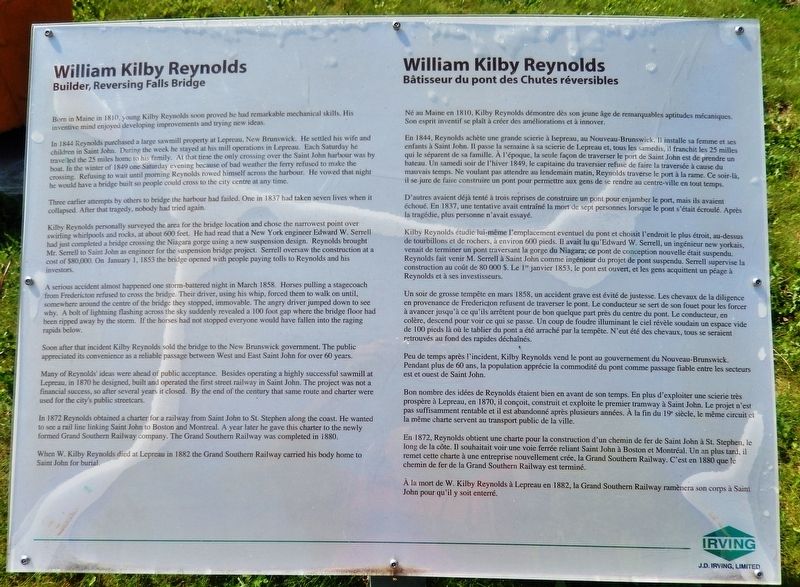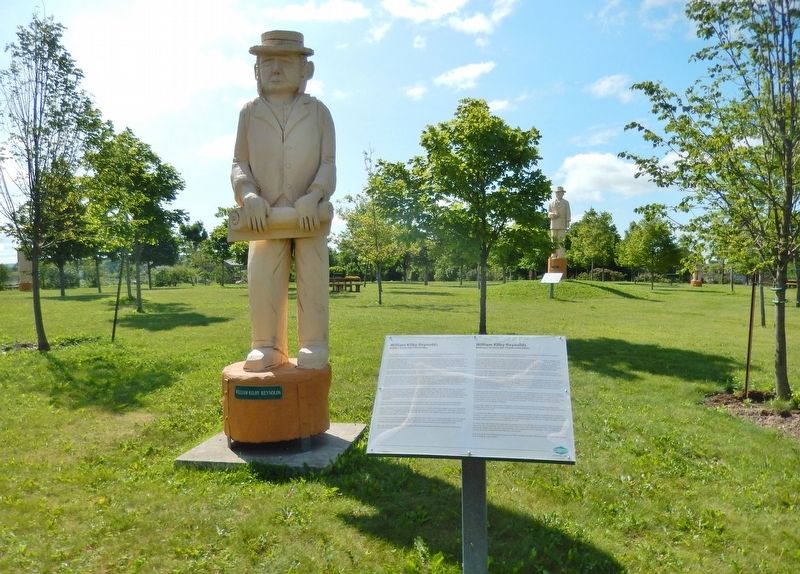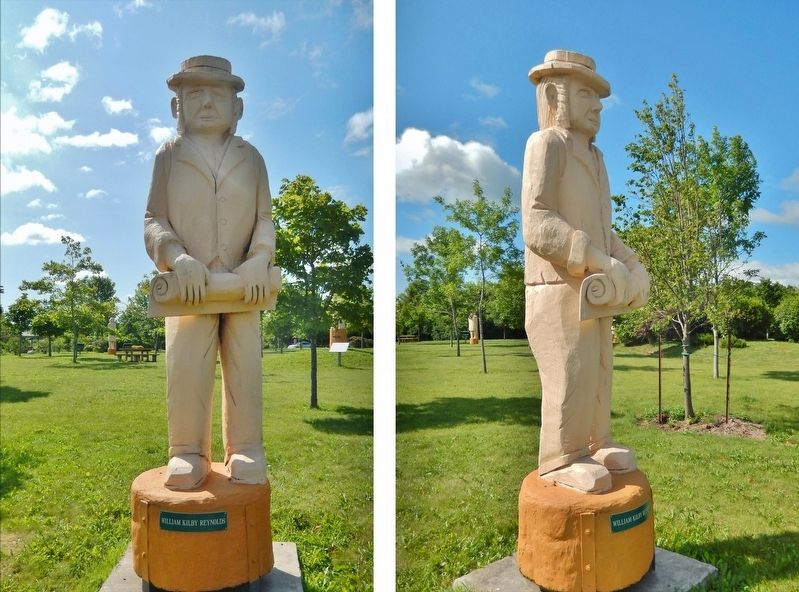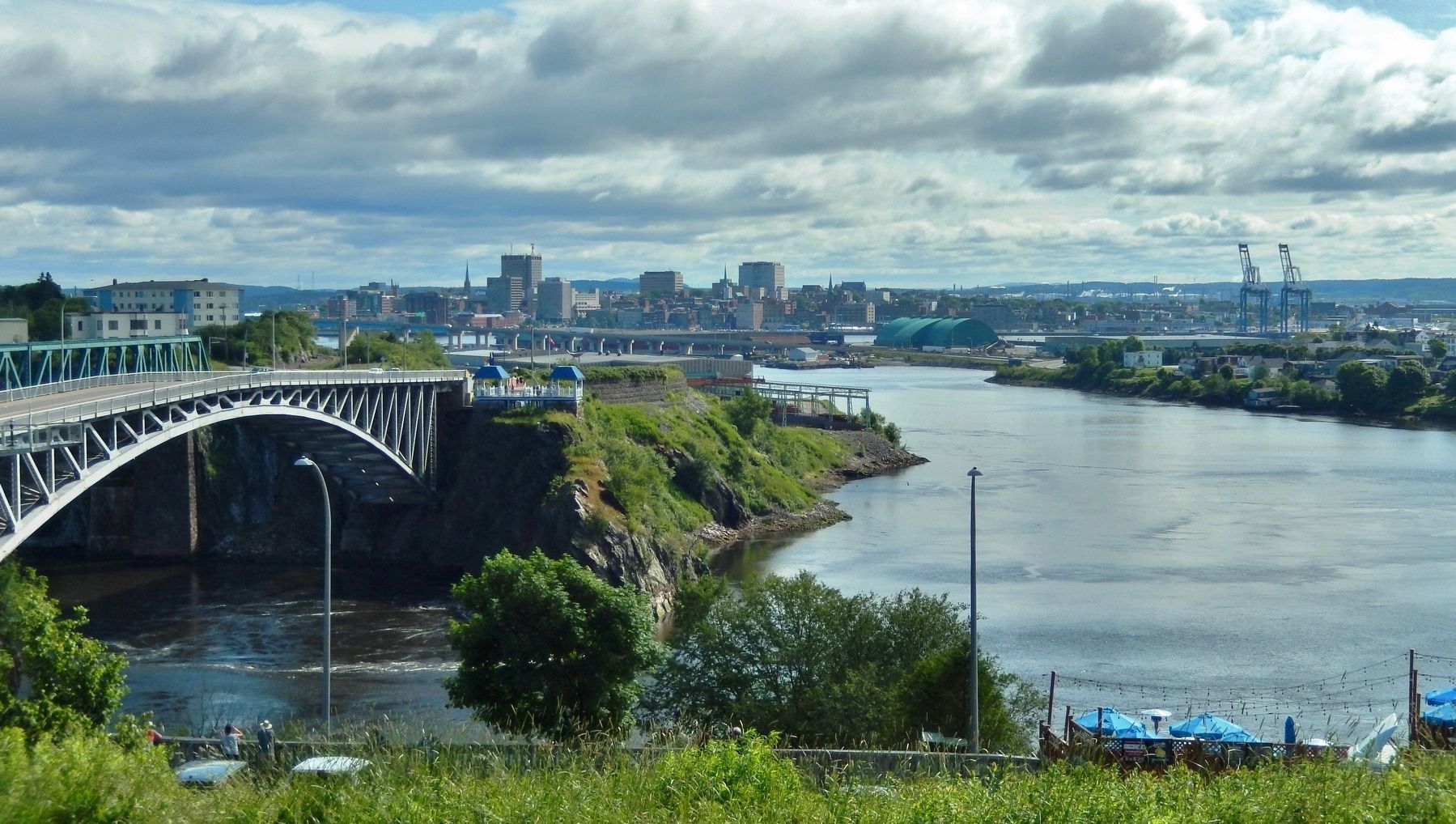Saint John in Saint John County, New Brunswick — The Atlantic Provinces (North America)
William Kilby Reynolds
Buider, Reversing Falls Bridge / Bâtisseur du pont des Chutes réversibles
Born in Maine in 1810, young Kilby Reynolds soon proved he had remarkable mechanical skills. His inventive mind enjoyed developing improvements and trying new ideas.
In 1844 Reynolds purchased a large sawmill property at Lepreau, New Brunswick. He settled his wife and children in Saint John. During the week he stayed at his mill operations in Lepreau. Each Saturday he traveled the 25 miles home to his family. At that time the only crossing over the Saint John harbour was by boat. In the winter of 1849 one Saturday evening because of bad weather the ferry refused to make the crossing. Refusing to wait until morning Reynolds rowed himself across the harbour. He vowed that night he would have a bridge built so people could cross to the city centre at any time.
Three earlier attempts by others to bridge the harbour had failed. One in 1837 had taken seven lives when it collapsed. After that tragedy, nobody had tried again.
Kilby Reynolds personally surveyed the area for the bridge location and chose the narrowest point over swirling whirlpools and rocks, at about 600 feet. He had read that a New York engineer Edward W. Serrell had just completed a bridge crossing the Niagara gorge using a new suspension design. Reynolds brought Mr. Serrell to Saint John as engineer for the suspension bridge project. Serrell oversaw the construction at a cost of $80,000. On January 1, 1853 the bridge opened with people paying tolls to Reynolds and his investors.
A serious accident almost happened one storm-battered night in March 1858. Horses pulling a stagecoach from Fredericton refused to cross the bridge. Their driver, using his whip, forced them to walk on until, somewhere around the centre of the bridge they stopped, immovable. The angry driver jumped down to see why. A bolt of lightning flashing across the sky suddenly revealed a 100 foot gap where the bridge floor had been ripped away by the storm. If the horses had not stopped everyone would have fallen into the raging rapids below.
Soon after that incident Kilby Reynolds sold the bridge to the New Brunswick government. The public appreciated its convenience as a reliable passage between West and East Saint John for over 60 years.
Many of Reynolds’ ideas were ahead of public acceptance. Besides operating a highly successful sawmill at Lepreau, in 1870 he designed, built and operated the first street railway in Saint John. The project was not a financial success, so after several years it closed. By the end of the century that same route and charter were used for the city's public streetcars.
In 1872 Reynolds obtained a charter for a railway from Saint John to St. Stephen along the coast. He wanted to see a rail line linking Saint John to Boston and Montreal. A year later he gave this charter to the newly formed Grand Southern Railway company. The Grand Southern Railway was completed in 1880.
When W. Kilby Reynolds died at Lepreau in 1882 the Grand Southern Railway carried his body home to Saint John for burial.
Né au Maine en 1810, Kilby Reynolds démontre dès son jeune âge de remarquables aptitudes mécaniques. Son esprit inventif se plaît à créer des améliorations et à innover.
En 1844, Reynolds achète une grande scierie à Lepreau, au Nouveau-Brunswick. Il installe sa femme et ses enfants à Saint John. Il passe la semaine à sa scierie de Lepreau et, tous les samedis, il franchit les 25 milles qui le séparent de sa famille. À l'époque, la seule façon de traverser le port de Saint John est de prendre un bateau. Un samedi soir de l'hiver 1849, le capitaine du traversier refuse de faire la traversée à cause du mauvais temps. Ne voulant pas attendre au lendemain matin, Reynolds traverse le port à la rame. Ce soir-là, il se jure de fane construire un pont pour permettre aux gens de se rendre au centre-ville en tout temps.
D'autres avaient déjà tenté à trois reprises de construire un pont pour enjamber le port, mais ils avaient échoué. En 1837, une tentative avait entraîné la mort de sept personnes lorsque le pont s'était écroulé. Après la tragédie, plus personne n'avait essayé.
Kilby Reynolds étudie lui-même l'emplacement eventuel du pont et choisit l'endroit le plus étroit, au-dessus de tourbillons et de rochers, à environ 600 pieds. Il avait lu qu'Edward W. Serrell, un ingénieur new yorkais, venait de terminer un pont traversant la gorge du Niagara; ce pont de conception nouvelle était suspendu. Reynolds fait venir M. Serrell à Saint John comme ingénieur du projet de pont suspendu. Serrell supervise la construction au coût de 80 000 $. Le 1er janvier 1853, le pont est ouvert, et les gens acquittent un péage à Reynolds et à ses investisseurs.
Un soir de grosse tempête en mars 1858, un accident grave est évité de justesse. Les chevaux de la diligence en provenance de Fredericton refusent de traverser le pont. Le conducteur se sert de son fouet pour les forcer à avancer jusqu'à ce qu'ils arrêtent pour de bon quelque part près du centre du pont. Le conducteur, en colère, descend pour voir ce qui se passe. Un coup de foudre illuminant le ciel révèle soudain un espace vide de 100 pieds là où le tablier du pont a été arraché par la tempête. N'eut été des chevaux,
tous se seraient retrouvés au fond des rapides déchaînés.
Peu de temps après l'incident, Kilby Reynolds vend le pont au gouvernement du Nouveau-Brunswick. Pendant plus de 60 ans, la population apprécie la commodité du pont comme passage fiable entre les secteurs est et ouest de Saint John.
Bon nombre des idées de Reynolds étaient bien en avant de son temps. En plus d'exploiter une scierie très prospère à Lepreau, en 1870, il conçoit, construit et exploite le premier tramway à Saint John. Le projet n'est pas suffisamment rentable et il est abandonné après plusieurs années. À la fin du 19e siècle, le même circuit et la même charte servent au transport public de la ville.
En 1872, Reynolds obtient une charte pour la construction d'un chemin de fer de Saint John à St. Stephen, le long de la côte. Il souhaitait voir une voie ferrée reliant Saint John à Boston et Montréal. Un an plus tard, il remet cette charte à une entreprise nouvellement crée, la Grand Southern Railway. C'est en 1880 que le chemin de fer de la Grand Southern Railway est terminé.
À la mort de W. Kilby Reynolds à Lepreau en 1882, la Grand Southern Railway ramènera son corps à Saint John pour qu'il y soit enterré.
Erected by J.D. Irving, Limited.
Topics. This historical marker is listed in these topic lists: Bridges & Viaducts • Man-Made Features • Railroads & Streetcars. A significant historical date for this entry is January 1, 1853.
Location. 45° 15.423′ N, 66° 5.417′ W. Marker is in Saint John, New Brunswick, in Saint John County. Marker can be reached from Lancaster Avenue, 0.2 kilometers east of Bridge Road (New Brunswick Route 100), on the left when traveling east. Marker is located along the walking path in Wolastoq Park, near the center of the park. Touch for map. Marker is at or near this postal address: 211 Lancaster Avenue, Saint John NB E2M 2K8, Canada. Touch for directions.
Other nearby markers. At least 8 other markers are within walking distance of this marker. Robert Foulis (here, next to this marker); Charles Gorman (a few steps from this marker); Sir Samuel Leonard Tilley (a few steps from this marker); K.C. Irving (within shouting distance of this marker); Thomas Stockwell Simms (within shouting distance of this marker); George B. Oland (within shouting distance of this marker); John Robertson (within shouting distance of this marker); The New Community of Saint John (within shouting distance of this marker). Touch for a list and map of all markers in Saint John.
Related markers. Click here for a list of markers that are related to this marker. Wolastoq Park
Also see . . . The Suspension Bridge at Saint John - W. K. Reynold's brilliant achievement. Known during his lifetime as the "Projector" of the great suspension bridge at Saint John, Reynold's was truly a giant among men, and not incidentally, a productive New Brunswick historian and publisher.
Erected after other attempts failed.
It was for years a Toll Bridge
Then made free to the Public.
Opened for use 1853.
Removed 1915.
Credits. This page was last revised on November 4, 2019. It was originally submitted on October 31, 2019, by Cosmos Mariner of Cape Canaveral, Florida. This page has been viewed 248 times since then and 11 times this year. Photos: 1, 2, 3, 4. submitted on November 4, 2019, by Cosmos Mariner of Cape Canaveral, Florida.



